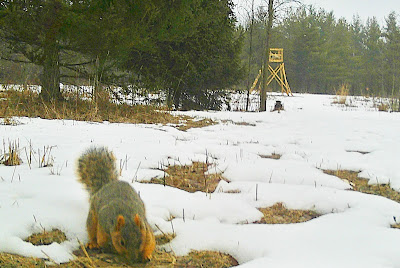Most of my adult life my exposure to squirrels was namely city-dwelling Eastern Gray Squirrels. They were ubiquitous to urban life and were more of an annoyance if anything. They raided bird feeders, gnawed-on house siding and soffit and invaded attics and fireplace chimneys.
As a young man fall grouse hunting in Vilas County always brought small red squirrels - the chattering class.
When we purchased this farmland 30 years ago there wasn't a tree-dwelling squirrel, red, gray or otherwise, to be found. Ground squirrels tunneled in the septic mound and took-up
residence in the rock wall. That was the extent of our known squirrel
population
Beginning with 2018 another species of squirrel arrived.
Meet Sciurus niger - the Eastern Fox Squirrel - the largest of the tree squirrel family.
At first blush you might guess this to be a Red Squirrel. However, lacking in this photo is the Red Squirrel's distinctive bright white belly and white rings around the eyes. At twice the size, the rusty coloring and large bushy tail are reminiscent of a fox - implying this is a Fox Squirrel.
The bright orange pelt of this animal and it's loud, scolding call make it an easier visual and audible identification. Unlike the Eastern Gray Squirrel this species has a wider home range and spends more time on the ground foraging.
In the last three years they've been showing-up with increasing frequency on the trail cameras. My conclusion is that as our forest has matured along with acorn production from the oaks is that the resident population has increased. They are everywhere and frequently one of the more common critters appearing on the trail cameras.
They're active year-round and January and February is their mating season so there's likely more chasing of the ladies happening too.
Fun to observe and without destructive tunneling behavior I'm tickled (so far anyway) to have them around.





No comments:
Post a Comment